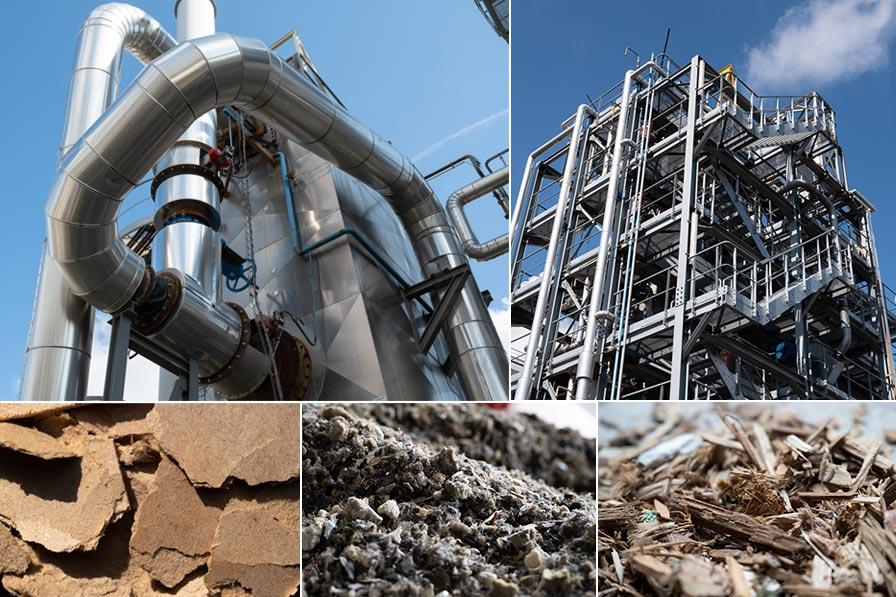PLAINÉNERGIE: second phase of the partnership

PLAINÉNERGIE's partners1 have successfully completed the first phase of the programme. The CCPA, the SMPIPA, GRTgaz, Séché Environnement and Enosis are now embarking on the second phase. It involves coupling pyrogasification and biological2 methanisation3 at semi-industrial scale in order to validate the quality of gas produced using solid waste from the Plaine de l’Ain (end-of-life wood, large objects from the waste collection centre, waste generated by business, etc.) which traditional sectors have difficulty recovering. The aim of the partnership is to confirm the benefits of this waste processing solution so that renewable and low-carbon gas can be produced locally. The PLAINÉNERGIE programme therefore helps deliver the energy transition, while at the same time playing a part in developing the circular economy across France's regions.
PLAINÉNERGIE is a collaborative programme, designed to meet the needs of the Plaine de l’Ain in the Auvergne-Rhône-Alpes Region. Thanks to the diversity of its partners, it is in a position to cover all stages of the value chain – from waste treatment through to the production of sustainable energy, all as part of a circular economy approach. PLAINÉNERGIE aims to convert residual waste, or waste that has only been partially recovered4 from across the Plaine de l’Ain region into gas. This gas can then be injected into the existing gas network. By coupling two processes – pyrogasification and biological methanisation – this renewable or low-carbon gas can be used instead of imported fossil gas.
PLAINÉNERGIE is a comprehensive programme. Structured into phases, it covers the various stages in the development of the solution – from waste characterisation and laboratory testing through to construction of an experimental industrial plant – the first such plant that can be replicated across regions other than the Plaine de l’Ain.
1 PLAINÉNERGIE is currently made up of the Plaine de l’Ain intercommunal structure (the CCPA), the Plaine de l’Ain joint industrial facilities association (the SMPIPA), GRTgaz, Séché Environnement and Enosis
2 Pyrogasification: process whereby solid waste is heated at high temperatures (between 800 and 1500°C) in a low-oxygen (or zero-oxygen) environment so as to convert it into gas.
3 Methanisation: process for converting carbon monoxide (CO) and carbon dioxide (CO2) into methane (CH4) using a chemical reaction with hydrogen (H2).
4 End-of-life wood, bulky waste from recycling centers, waste from economic activities, etc.
A successful first phase involving the identification of waste to be recycled
The first phase established that the Plaine de l’Ain has some 8600 tonnes of waste that can be used for pyrogasification annually. And once it has been converted into renewable or low-carbon gas, it can meet the energy needs of more than 1000 homes.
Provademse conducted a study of the region's residual waste reserves, and qualified the portion that is suitable for pyrogasification. It then successfully demonstrated (at its platform), that this waste could be converted into “syngas”.
At the same time, Enosis and its partners demonstrated, in a laboratory setting, the feasibility and benefits of using biological methanisation to produce renewable or low-carbon gas from this syngas that can be used as a substitute for natural gas.
The start of the second phase: implementing a semi-industrial scale demonstrator
The CCPA, the SMPIPA, GRTgaz, Séché Environnement and Enosis have today announced the continuation of the PLAINÉNERGIE programme as the second phase gets underway. This involves a demonstration on a semi-industrial scale, conducted at the ERBE platform of the LERMAB, the University of Lorraine's laboratory for the study and research of wood materials, located in Epinal on the Bois Campus.
Several test campaigns are scheduled to run between July and November this year. They will involve converting waste from the Ain plain area, supplied by the CCPA and Séché Environnement, into gas that can be injected into the network. This waste will be processed using the (small-scale) industrial pyrogasification plant developed by EQTEC, operated by the LERMAB, linked to the semi-industrial biological methanisation unit – BIMOTEP –, designed by Enosis.
Séché Environnement is contributing its industrial expertise in process integration and the operation of waste recovery centres.
GRTgaz, via its RICE research laboratory, carries out in-depth analysis of the renewable or low-carbon gas obtained, to ensure that it complies with the specifications required for injection into existing gas networks.
PLAINÉNERGIE is unique, and brings together both public and private stakeholders within the framework of a regional innovation approach. It is perfectly aligned with the objectives of the French Strategy for Energy and Climate, and meets the aims of the country's Green Industry plan.
Pyrogasification for injection – a major sector for France’s regions and its gas industry
Pyrogasification for injection into existing gas networks promotes the recovery of residual waste from regions at local level and is underpinned by a circular economy approach. It helps to bolster France's energy sovereignty, as well as helping to reduce greenhouse gas emissions, alongside other renewable and low-carbon gas production channels (methanisation, power-to-methane, hydrothermal gasification and hydrogen).
The first industrial-scale pyrogasification projects are expected to mature between now and 2025.
By 2030, provided that legislation and regulations are appropriately amended, network operators' forecasts, based on the aims enshrined in regional development planning projects (regional schemes for town planning, sustainable development and equality, etc.), show that pyrogasification could recover 3 million tonnes of waste per year. This equates to 6 TWh of renewable or low-carbon gas being injected into networks.
By 2050, the ADEME predicts that up to 67 TWh5 of renewable and low-carbon gas could be produced by pyrogasification in France. This will be enough to meet 30% of French gas consumption by this time.
5 ADEME, Transition(s) 2050, November 2021
Press contact
To go further

PLAINÉNERGIE: transforming our residual waste into renewable gas
